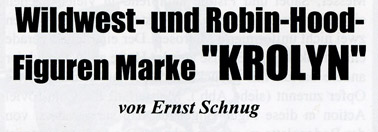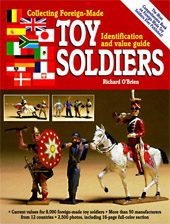|
GUIDO KROHN-RASMUSSEN
By Helge Scheunchen
Photo: Leif Pedersen
The firm was founded in 1946 by Guido Krohn-Rasmussen (9th Sep.1896 - 27th Feb.1979).
In his youth he had lost a leg and his last
years were spent as a blind man at the nursing home Møllegården in Bagsværd, Copenhagen.
Krohn-Rasmussen used his own name for the firm in the beginning. A good
friend, Knud Lyngsaa, who was an assistant secretary in the Danish Ministry
of Agriculture quit his job and joined him in 1950. Then the name
KROLYN was registered. It was formed by the first three letters of each of the two
surnames. Knud Lyngsaa soon left again, as he was not satisfied with the
outcome.
When the English came to Denmark in 1945 they unsuccessfully tried to destroy
the German industry by declaring all German patents not valid. Now everybody could
legally copy products from Germany. Furthermore Denmark was obliged with a
lot of cheap aluminium which until then had been very scarce.
It came as sent from heaven. A 150 German airplanes that had been destroyed
by the Germans themselves prior to the surrendering of Flyvestation Værløse,
all ended up as scrap metal which could be reused!
This is where Guido Krohn-Rasmussen seriously stepped into the picture. He
got the idea of casting in this aluminium and he added silicon to make it
even stronger. It was a huge success. His son Frits later told that he
always had a figure in his pocket when he was a boy. His greatest pleasure was
asking big strong men if they could break the figure in their hands. It
never happened!
Initially only models of airplanes were made. They were mostly meant to be
used for exhibition. Then came the 7,5 cm figures that were mainly copies of
Elastolin and Lineol figures.
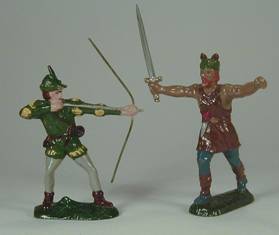
KROLYN no. 1001 and 1004:
Robin Hood and Guy of Gisborne.
|
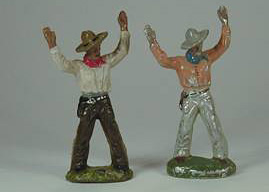
Tom Hutter: Lineol left, KROLYN no. 1205 right.
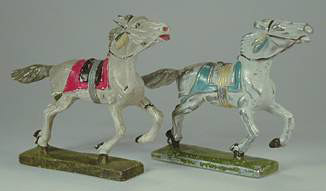
Indian horses: Lineol left, KROLYN right.
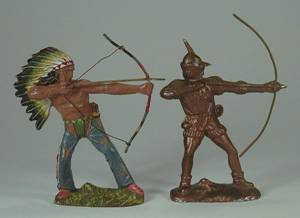
This
Lineol indian was obviously a model
for KROLYN no. 1001 Robin Hood. (Here in bronze).
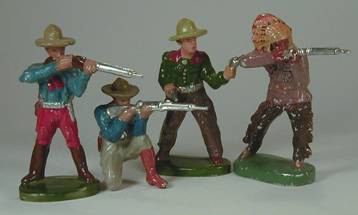
KROLYN cowboys and an indian.
All are copies of Elastolin figures.
|
|
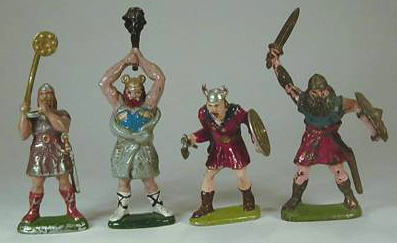
A selection of KROLYN´s Vikings.
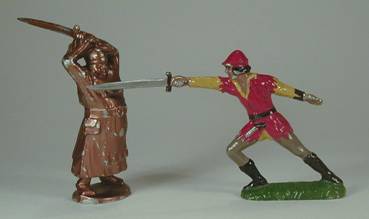
KROLYN no. 1007 and 1006: Friar Tuck and Allan à Dale. |
The introduction of aluminium
figures in Denmark was of far more importance though. The figures were
painted in private homes as spare time jobs. People wearing glasses would
not qualify because Krohn-Rasmussen thought they were unable to do the job
properly. The painting was done in shiny festive colours. Unfortunately
without use of grounder! Today we see the result of this: Many of the figures
stand almost totally blanc because the paint has come off.
The Vikings are the most original KROLYN figures. Some of them are marked 'RØDE ORM'
and have a number on the base, referring to the name of the figure. These
fierceful warriors depict the heroes from the book 'Røde Orm' by Swedish
author Frans G. Bengtsson, who enjoyed enormous popularity in Denmark in
those years. The book was issued both in 1942 and in 1946. It was a founding
idea by KROLYN to make portrait figures of boys heroes like Buffalo Bill and
Yellow Wolf, Robin Hood and his merry men and the knights Guy of Gisborne
and Ivanhoe. Last but not least Hamlet should be mentioned. He was cast in
the classical pose saying:
”To be, or not to be!”
Thanks to Leif Pedersens colour pictures of KROLYN´s figures and text, it
has been possible for us to show the copying. But it should also be said
that Krohn-Rasmussen was convinced that he had acted in good belief when he
started production following the collapse of Germany. Not until late in the 1950s
a German law-suit seemed to be under way because of KROLYN's copying of
Elastolin figures. The trial was never to be though!
In 1957 Krohn-Rasmussen sold his firm to Anne Lise Klinke. Soon after a new
owner took over and kept Krolyn going until 1960. Once again, in
1962, it was sold and hereafter the firm soon vanished for good.
Most of the pictures can be seen
in large format in "Gallery".
This article was made by members of
Figurina Danica.
Translation by tohan, January 2008. |
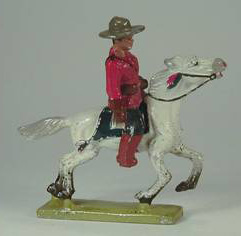
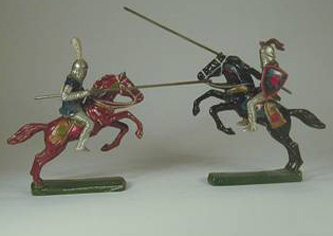
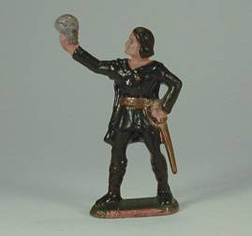 KROLYN´s Hamlet.
KROLYN´s Hamlet.






